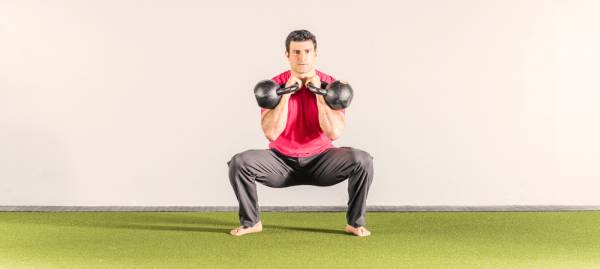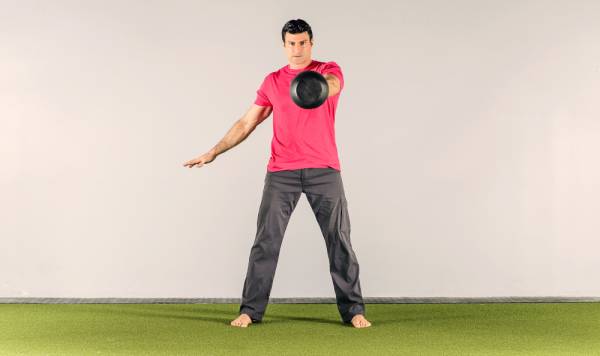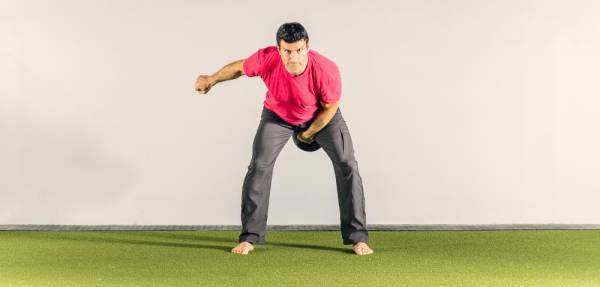Kettlebells are great for many reasons. They provide a kick-ass workout without the need for much equipment or a large space.
And nearly everyone I’ve met who uses kettlebells has a story that sounds something like this, “A friend showed me how to do some swings and it didn’t look so hard, so I did twenty and it took about five minutes for my heart rate to return to normal.”
The swing is a great exercise. It’s easy to learn, and it ticks a lot of boxes from posterior chain work, to hip hinging, to even developing the grip and providing some incidental cardiovascular training.
RELATED:3 Deadly Sins of the One-Armed Kettlebell Swing
Two-Hand Swing
The two-hand swing is the first version of the swing you learn and often the one people return to most simply for its convenience. But there are two other versions of the swing that should get used far more – the one-hand swing and the double swing.
The Problem With Using Two Hands
For starters, and this opinion is never popular, kettlebells are not designed to be used with two hands. I am well aware there are many exercises you can do with two hands with kettlebells that are great, but these are all patterning exercises for more advanced variations to come later on in your training.
RELATED:Beyond the 2-Handed Swing:5 Movements You May Be Neglecting
Take the goblet squat as an example. The goblet squat was invented by necessity by Dan John to quickly teach a room of high school kids the correct mechanics of squatting without needing to give an hour-long lecture on the subject. It is a patterning exercise.
“For starters, and this opinion is never popular, kettlebells are not designed to be used with two hands.”
Anyone who has tried to squat with one of the bigger bells – like a 40+kg bell – will tell you the hardest part of the exercise isn’t the squat, but holding it in place. While there may be some benefit to making that aspect harder, we’re doing the exercise to teach squatting – not holding on. So at that point, it becomes smarter to use two kettlebells and squat with doubles. At that point, you can be confident the squat pattern is solid and now it’s time to start working with more weight.

Double-Kettlebell Squat
Benefits of One-Hand Swings
The same holds true of the two-hand swing. We use the two-hand swing to initially teach the swing, but one-hand and double swings are far more beneficial in the long term. (Double swings are performed with a bell in each hand and are actually two one-hand swings performed simultaneously.)
RELATED:How To Do The Perfect Kettlebell Swing
While the two-hand swing teaches us how to brace and create midline stability in the sagittal plane, the one-hand swing adds an anti-rotation component. Meaning, we are effectively killing more birds with the same cannonball with a handle than if we do two-hand swings. If training time is short, you’re better off getting more done in a single exercise.
Not only that but the one-hand swing allows us to work the grip harder, which in turn means we need to stabilize the shoulder more. In the FMS system, the one-hand swing is the final proof of a stable shoulder due to this grip-stability relationship that is derived from packing the shoulder properly.
“While the two-hand swing teaches us how to brace and create midline stability in the sagittal plane, the one-hand swing adds an anti-rotation component.”
And when we add in the control of rotary forces, what we have is an exercise that covers other FMS domains, such as the active straight leg raise (as the swing in any form is the final proof of that being adequate), shoulder mobility, the trunk stability push up, and rotary stability. Because these four elements make up the functional patterns in the FMS test, we know if we address these, or at least prove our ability to do them, then we will be able to do a host of other athletic movements, too.

One-Hand Swing
A Simple Progression for One-Hand Swings
For many people, the toughest part of learning the one-arm swing won’t be the swing action itself. That should have been adequately covered in all the initial pattering work you did with the two-hand swing. Instead, the thing they’re going to most struggle with is learning to pack and control the shoulder properly.
So, here’s a simple progression to make that transition from two-hand to one-hand swings easier and fix any pesky shoulder problems you might have along the way.
Step 1 – Side Planks
In this position, we are unloaded and close to lying – our most basic posture for learning patterns. All the work is done by learning to keep the shoulder stable and linking that through the rest of the body to prevent the body sagging to the ground.
Step 2: Split Squats With Weight Held Contralaterally
Starting from the bottom of the lunge, hold the kettlebell in your opposite hand. Meaning, if your left foot is forward, then hold the weight in your right hand.
This cross-body pattern resembles gait, but in this case we’re using it simply because it’s easier and allows you to better control what you’re doing at the shoulder. The purpose here is not to smoke the legs with lunges, but to make sure the trunk stays braced and the shoulder packed.
Step 3: Suitcase Deadlifts
We use the deadlift to teach the two-hand swing because the deadlift is done at a much slower pace and it allows you to really feel what you should be doing without the stress of the high speed of the swing. So why aren’t we using the suitcase deadlift to teach the one-arm swing for the same reason?
“The key to this movement is that body shouldn’t tip sideways or lose posture in any way.”
When doing this movement, focus on drawing the shoulder blade into the opposite hip corner and shortening the body by contracting down the obliques. The key to this movement is that body shouldn’t tip sideways or lose posture in any way. If it does, then either the weight is too heavy to learn with or you need to regress a step until better control is possible.
Step 4: One-Hand Swing
Keep all the things worked on up until this point consistent – the hinge taught in the two-hand swing, neutral spine, full hip extension at the top of the swing, breathing, and the shoulder packing learned during the three preceding steps. Do all those pieces and your one-hand swing will be great.
RELATED:Scientific Analysis of the Kettlebell Swing, Snatch, and Carry

One-Hand Swing
The Perfect Handheld Gym
The bonus of one-hand swings is that while we get a large degree of shoulder stability and anti-rotation work from them, we don’t stress out our shoulders in the same way as when we snatch. For many people that overhead position done quickly and under load is a recipe for disaster.
Conversely, the one hand-swing ticks many training boxes in a safe and time-efficient manner. It will help build skill for more advanced drills that can all be done with one bell in a small space, making it the perfect handheld gym.
Photos 1, 2, 3, & 5 courtesy ofCraig Marker.
Photo 4 courtesy ofShutterstock.






